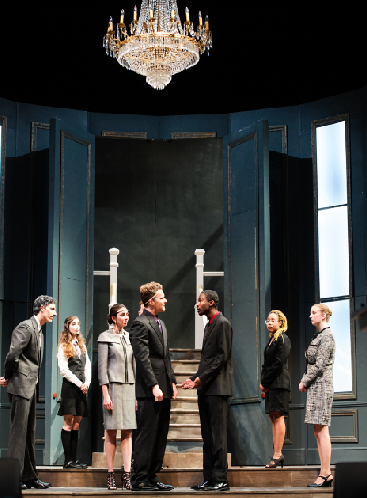
The Hamilton College Theatre Department’s production of
Hamlet
, directed by Mark Cryer, is an incredible adaptation of Shakespeare’s 17th century play. The performances on April 12–14 took place in the F. Eugene Romano Theatre. This flexible black box theater contributed to the sense of Shakespeare’s classic mysticism and complexity.
The theme of Hamlet’s madness also came through in the physical set of the play, which included two-story moving doors and panels, a pair of gliding walls, a hidden elevator, and projectors. As Hamlet tumbled into his state of madness, Claudius, (William Benthem de Grave ’20) and Polonius (Will Kaback ’20), descended into a room that rose up from the floor. There were multiple computer monitors in the room, through which Claudius and Polonius observed Hamlet in the palace. The surveillance video, along with the multiple mirrors on the back stage, created multiple eerie dimensions on set. The flex theater’s projectors created full-sized animations of the King of Denmark onto the back-drop and a hanging projector screen. Amidst the dense Shakespeare language, the application of modernism to the play made it more accessible for the 21st century audience to understand.
The theatrical talent was incredible across the board for all of the student actors. Tommy Bowden ’18 starred as Hamlet and owned the stage with confidence, convincingly portraying Hamlet’s madness as the play progressed. His t-shirt, worn in the second act, read “It was all a dream,” encapsulating his state of mind as he attempted to avenge the death of his father, the King of Denmark. Benthem de Grave played a deceiving King Claudius (equipped with streaks of grey hair and convincing wrinkles), while Olivia Melodia ’18 played the vulnerable Gertrude. Angelique Archer ’20 stole the show as Ophelia when she, like Hamlet, became overcome with madness. During the second act, she stepped out onto the stage wearing a beautiful, asymmetrical wedding dress and danced around in circles with bare feet, exposing her broken heart to the other characters. Her eyes, opened wide with hysteria, put the audience on the edge of their seats. No one was left wondering why Ophelia drowned herself after that scene.
The Theatre Department’s production of
Hamlet
spiced up traditional gender roles by assigning female actors to the traditionally male characters of Horatio (Mackenzie Bettmann-Adcock ’18) and Rosencrantz & Guildenstern (Jojo Rhinehart-Jones ’20 & Noelani Stevenson ’19) also known as “gender bending.” All three actresses wore their hair down and did not attempt to look like men. Their female personalities added a touch of originality and modernism to the production.
Despite the impressive sets, the incredible acting, detailed makeup, and clever costumes,
Hamlet
stood out with its well-rehearsed stage combat. The combat scenes, taking place mostly in the second act, were seamless and incredibly realistic, as well as artful. Bowden, revealed that he, along with Claudius (Benthem de Grave), and Laertes (Adrian Summers ’19) received stage-combat lessons from a Broadway professional, who arrived in January and taught the actors in six to eight-hour intensive sessions. This was in addition to all of the rehearsals that the actors attended, which began during the second week of classes in January.
If you are opposed to Shakespeare, plays in general, or even
Hamlet
specifically, you should still make an effort to see this performance. Not only is it well-executed, but it is tastefully done and accessible for all audiences. Support your fellow students and see it before it is too late! The final performances are April 18–21 at 7:30 PM and a matinée on April 21st at 2 PM.

















